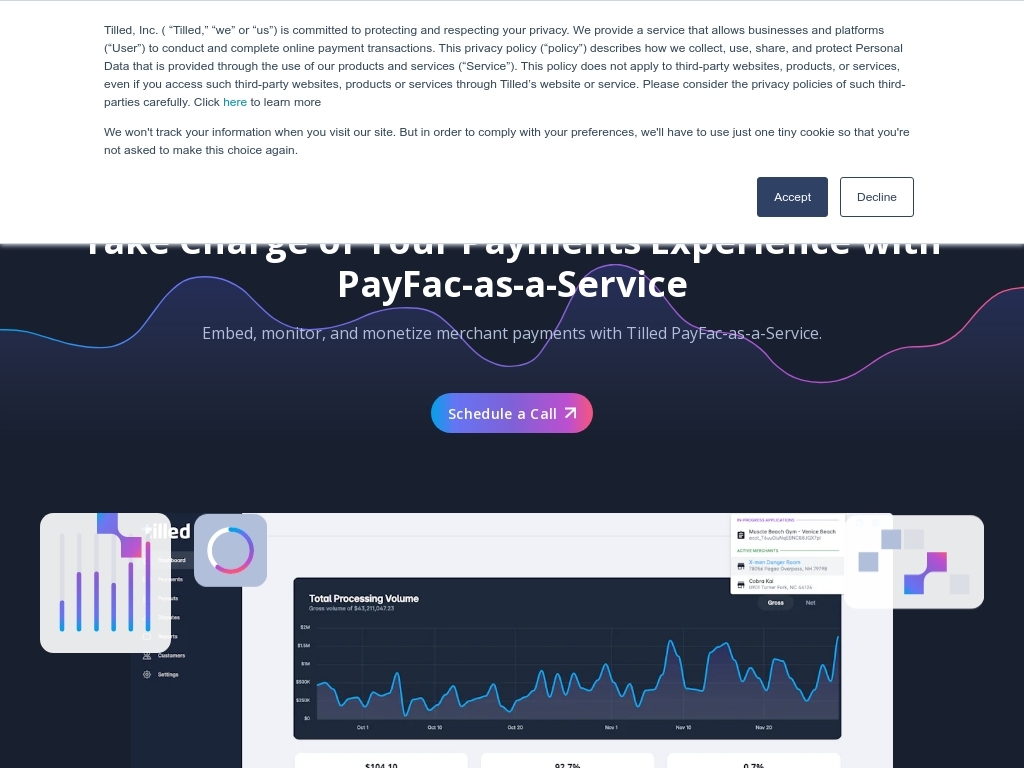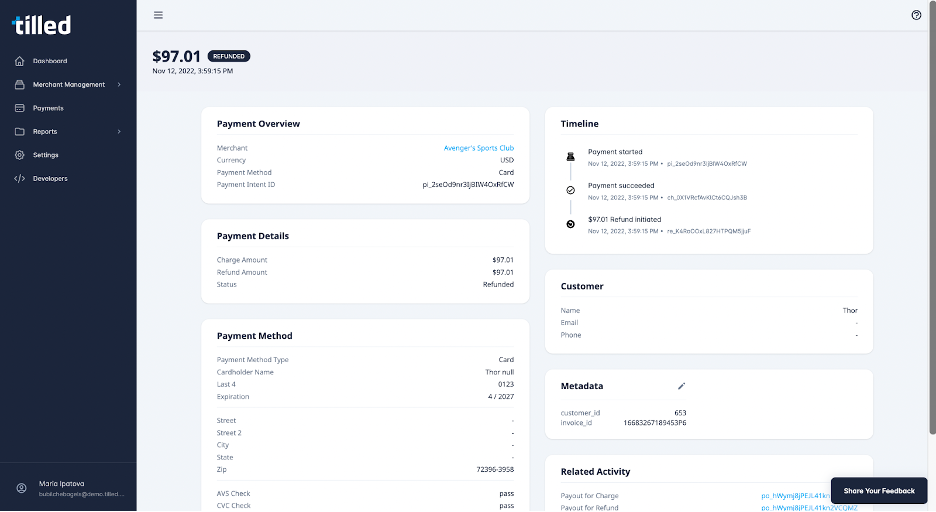
How Caleb Avery Built Tilled to Simplify Payments and Hit Seven-Figure Revenues
Who is Caleb Avery?
Caleb Avery, founder of Tilled, started his career in the payments industry at 19 years old, co-founding a credit card processing sales organization while in college and later pivoting to consulting and angel investing in vertical software platforms.

What problem does Tilled solve?
Tilled provides software companies with a seamless, instant onboarding and payment processing platform, eliminating the lengthy, costly process of becoming their own payment facilitator, thereby enhancing customer experience and significantly boosting revenue.


How did Caleb come up with the idea for Tilled?
Caleb Avery, the founder of Tilled, spent nearly a decade in the payments industry and constantly faced frustrations from his clients about the unsatisfactory onboarding process and the struggle to monetize payments. He observed that while many businesses streamlined their core product implementations, the payment processes remained cumbersome, requiring lengthy paperwork and waiting periods. This often resulted in a poor customer experience and drop-offs.
Recognizing that the solutions on the market didn't meet the dual needs of quick onboarding and revenue maximization, Caleb began researching what it would take to create a better solution. He consulted with large software companies and delved into existing PayFac-in-a-Box providers, learning that while these options existed, they required significant time and financial investment, making them unrealistic for most companies.
Caleb validated his idea by examining the challenges his consulting clients faced and envisioning a platform that offered a seamless, instant onboarding experience combined with strong economic benefits. Despite encountering skepticism and realizing the tough path ahead, Caleb refined his approach based on feedback and his deep industry insights. The primary lesson he learned was the necessity of marrying technology with user-centric design and transparent, fair economics, which led to the creation of Tilled’s PayFac-as-a-Service platform.
How did Caleb Avery build the initial version of Tilled?
To build Tilled, Caleb Avery first hired a CTO who prioritized building a world-class team to handle the technical aspects of the platform's development. This initial team took around 10 months to release the first iteration of the product, which later required a complete rebuild that took an additional eight months. In terms of the tech stack, the primary focus was on developing robust APIs and thorough developer documentation, including dark mode for ease of use, to ensure a streamlined integration process for customers. Shifting to a white-label-first approach was crucial, as customers desired their own branding front and center, which led to a significant improvement in the user experience. Scaling and providing extensive automation for customer onboarding and support were key to overcoming early challenges, ultimately enabling Tilled to reduce the integration time for software companies from six months to an average of nine days.

What were the initial startup costs for Tilled?
- Product Development: The founder spent 18 months and raised around $40 million in capital to develop a sellable solution after the initial product required a complete rebuild.
- Marketing and Branding: Caleb invested in building his personal brand on LinkedIn, which drove 95% of their lead flow in the first year.
- Employee Costs: They hired a CTO, Matt, early on to build a world-class development team, although specific costs are not detailed.
- Unexpected Pandemic Costs: When the pandemic disrupted their initial outbound sales and trade show strategy, they pivoted to content marketing and personal branding.
How did Caleb launch Tilled and get initial traction?
LinkedIn Engagement
Caleb Avery, Tilled’s founder, heavily leveraged his personal LinkedIn profile to get the word out about Tilled. He initially had fewer than 500 followers but invested in creating consistent and engaging content. Caleb hired a ghostwriter to help generate high-quality posts that combined insights about the payments industry and personal anecdotes to connect more authentically with his audience. This engagement led to about 95% of their lead flow during the first year, bringing in numerous interested customers and even investors. Within a year, his LinkedIn presence grew substantially, contributing to nearly reaching their first million in ARR.
Channel Partners
Tilled also focused on establishing channel partnerships with ISOs (Independent Sales Organizations) and payments consultants who were already working with potential Tilled customers. Caleb’s appearance on a niche podcast targeting this audience led to 36 resellers reaching out within 24 hours. Tilled offered these partners attractive commissions and superior technology, which helped close a higher percentage of deals. This strategy brought consistent new partnerships and significantly contributed to their customer base.
Product Adjustment
When initial product feedback indicated that 80% of customers wanted full API integration without Tilled’s branding, Caleb and his team made necessary adjustments. They shifted to offering robust white-label solutions that allowed companies to use Tilled's infrastructure while maintaining their own branding. This change was critical, enabling Tilled to reduce their integration time dramatically and resulting in an average nine-day integration period, which was a significant improvement from the previous six-month duration.
By focusing on these tactics and strategies, Tilled was able to garner initial interest, convert it into consistent revenue streams, and quickly adapt their product to customer needs, laying the foundation for their growth.
What was the growth strategy for Tilled and how did they scale?
Caleb Avery, the founder of Tilled, leveraged his personal LinkedIn profile to drive significant inbound interest and engagement. Starting with fewer than 500 followers in 2020, he grew his following to 17,000 by sharing a mix of professional insights and personal experiences. His posts included both high-quality, long-form articles and more personal stories about his entrepreneurial journey, which helped humanize him and build rapport with potential customers and partners. This strategy contributed to 95% of their lead flow in the first year, pushing them close to their first million in ARR.
Channel Partnerships
Tilled also built a robust channel partnership strategy, collaborating with Independent Sales Organizations (ISOs) and payments consultants. These partners brought in deals from vertical software companies looking for better payment solutions than the ones currently available. Partners were attracted by Tilled’s ability to offer superior technology and competitive revenue share models. By providing comprehensive training resources, including video series and onboarding support, Tilled ensured their channel partners were well-equipped to sell their product, leading to consistent and scalable growth.
What's the pricing strategy for Tilled?
Tilled uses a combined pricing model with a $2,500 monthly SaaS fee and a revenue share model, allowing ISVs to control downstream merchant pricing and earn 75% of the revenue beyond the SaaS fee.
What were the biggest lessons learned from building Tilled?
- Identify and Target Ideal Customers: Initially, Tilled faced a significant challenge with attracting the right customers and had to realign their focus by identifying their Ideal Customer Profile (ICP). This strategy involved firing customers who didn't fit their ideal profile, ultimately leading to more sustainable growth.
- Invest in Personal Branding: Caleb Avery built a strong personal brand on LinkedIn by sharing both professional insights and personal stories. This authenticity drove significant inbound interest and was a primary driver for Tilled's early customer acquisition.
- Optimize Developer Experience: To compete with established players like Stripe, Tilled overhauled their developer tools and documentation. They focused on creating a seamless, intuitive experience which significantly reduced integration times from six months to nine days.
- Leverage Channel Partners: Tilled's use of ISOs and payment consultants as channel partners was crucial. These resellers brought in a steady stream of leads, with Tilled providing extensive training and support to ensure their success. This strategy allowed Tilled to scale quickly.
- Adaptability in Go-To-Market Strategy: The pandemic forced Tilled to pivot from an outbound sales strategy to content marketing and remote engagement. This adaptability not only helped them navigate a challenging period but also opened up new, effective ways to reach potential customers.
Discover Similar Business Ideas Like Tilled
|
|
Idea
|
Revenue
|
|---|
More about Tilled:
Who is the owner of Tilled?
Caleb Avery is the founder of Tilled.
When did Caleb Avery start Tilled?
2019
What is Caleb Avery's net worth?
Caleb Avery's business makes an average of $833K/month.
How much money has Caleb Avery made from Tilled?
Caleb Avery started the business in 2019, and currently makes an average of $10M/year.

Download the report and join our email newsletter packed with business ideas and money-making opportunities, backed by real-life case studies.

Download the report and join our email newsletter packed with business ideas and money-making opportunities, backed by real-life case studies.

Download the report and join our email newsletter packed with business ideas and money-making opportunities, backed by real-life case studies.

Download the report and join our email newsletter packed with business ideas and money-making opportunities, backed by real-life case studies.

Download the report and join our email newsletter packed with business ideas and money-making opportunities, backed by real-life case studies.

Download the report and join our email newsletter packed with business ideas and money-making opportunities, backed by real-life case studies.

Download the report and join our email newsletter packed with business ideas and money-making opportunities, backed by real-life case studies.

Download the report and join our email newsletter packed with business ideas and money-making opportunities, backed by real-life case studies.










